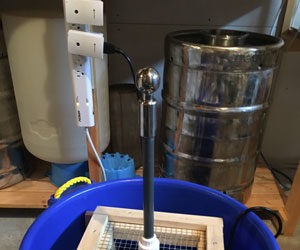Brew System Chiller: A time-saving upgrade

A little while back I purchased a Robobrew (Brewzilla) all-in-one brew system. It comes equipped with a good immersion chiller. If you have a system like this and you’re happy with it, then read no further. But if you’d like to make your chill time a little shorter and use less water, then I highly recommend a plate chiller. I won’t get into the details here of what makes a plate chiller awesome but there are many resources that can explain why, like the story found here: https://byo.com/article/wort-chilling-2/.
For 5-gallon (19-L) batches, a small 20-plate chiller will get the job done. Here in New England, we get very cold water in the wintertime. When I run my faucet at full speed, I can pump my wort directly into my fermenter at 70 °F (21 °C). In the summer it will take a bit longer so I’ll just recirculate back into the kettle until the Blichmann ThruMometer tells me that the wort is coming out at an appropriate temperature for direct pitching of the yeast.
Having the ThruMometer is optional, but it makes the chilling process that much easier since it takes the guesswork out of the process.
Using camlock quick disconnects is a no-brainer in my opinion. This allows you to bypass the recirculation arm and connect your chiller directly to your pump. Besides, the recirculation arm that comes with the Robobrew is designed for 3⁄8-in. ID tubing. That sizing means much slower flow rates. I recommend stepping up to the next diameter sized tubing . . . you’ll get much a much better flow rate with ½-in. ID tubing.
I chose to use male fittings on the wort-side of the chiller itself for a couple of reasons. Having both of them be male fittings means that you can connect your pump to either side of the chiller. This allows you to recirculate your cleaning fluid in both directions when you’re finished with it. Just be careful, because this also means you can run your wort in the wrong direction and not get very efficient cooling.
Having the ThruMometer is optional, but it makes the chilling process that much easier since it takes the guesswork out of the process. You can immediately see what temperature your wort is coming out at, which saves you time and energy. Once the wort reaches the appropriate temperature you can just put the out-tube directly into your fermenter. It only takes a couple of minutes for the pump to empty the entire Robobrew.
You will want to make sure to get the ½-in. ID and ¾-in. OD silicone tubing. Any thinner-walled tubing is not meant for hot liquid. It’s so thin that your tubes will immediately kink and stop the flow of wort. Also, you’ll want to make sure you use a proper braided hosing for your water-side. Using anything less strong could potentially burst. Trust me on this one . . . I now use a basic garden hose. (Did I learn this from experience? . . . no . . . why would you ask that?) Having quick disconnects on the water-side of the plate chiller is optional but awesome.
Tools and Materials
- Plate chiller — ½-in. NPT wort side and ¾-in. NPT water side
- (2) Male camlock — ½-in. NPT fittings
- Male camlock — ½-in. barb
- (2) Female camlock — ½-in. barb
- ½-in. ID, ¾-in. OD silicone tubing
- Garden hose
- (2) ¾-in. garden hose repair kits
- Teflon tape
- (2+) garden hose quick-disconnects (optional)
- Blichmann ThruMometer — ½-in. barbs (optional)


